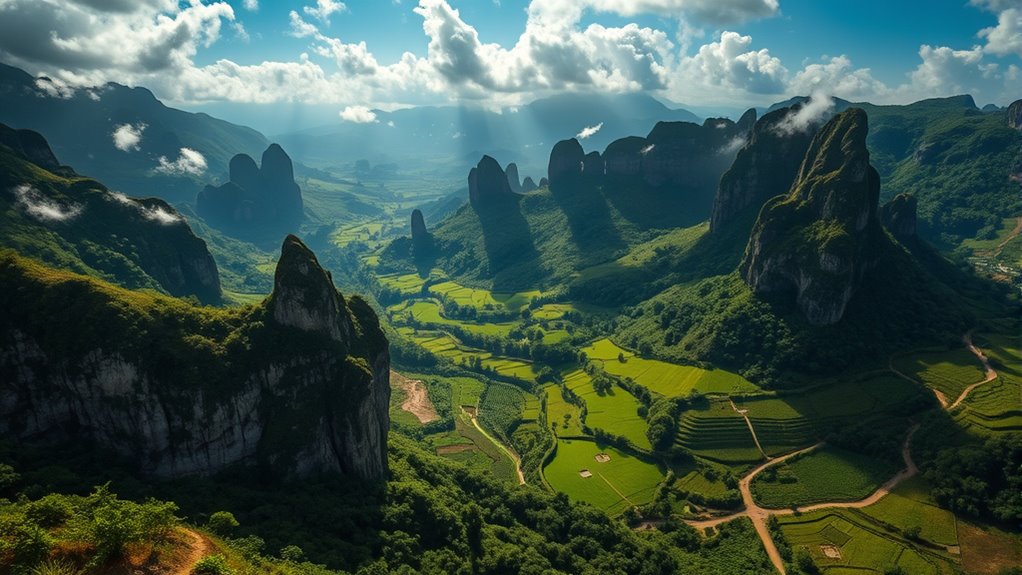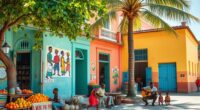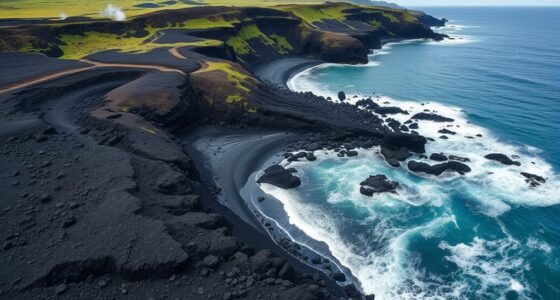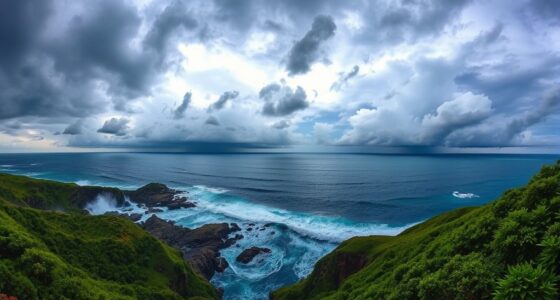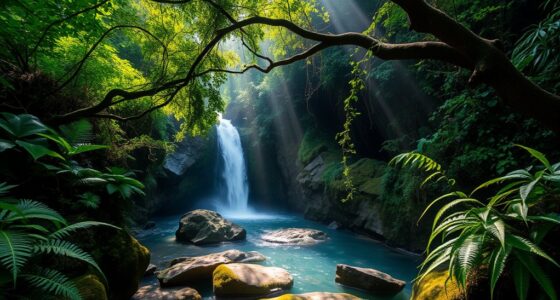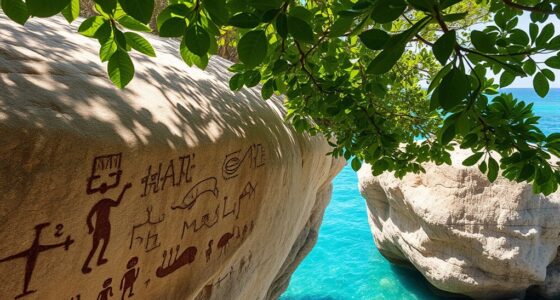In Cuba’s Viñales Valley, the limestone mogotes shape microclimates by creating shaded, cooler, and more humid areas, while open plains stay warmer and drier. These formations influence airflow and moisture, leading to diverse conditions across the landscape. This microclimate variation supports unique plant and animal life and adds a mysterious atmosphere with fog and wind. Exploring these features reveals the magical link between geology and climate—discover more about how geology defines this remarkable environment.
Key Takeaways
- Limestone mogotes shape the landscape, influencing airflow and shading, which creates varied microclimates within the valley.
- The porous limestone allows water seepage, fueling underground rivers that affect local humidity and temperature.
- Shade from mogotes generates cooler, more humid microclimates at valley bases, supporting diverse plant and animal life.
- Open plains in sunlight experience warmer, drier conditions, contributing to microclimate diversity across the region.
- Narrow gaps and caverns channel breezes and fog, adding to the valley’s unique climatic and atmospheric characteristics.

Nestled in Cuba’s lush western region, Viñales Valley is a breathtaking landscape where towering limestone mogotes rise dramatically from fertile plains. These striking karst formations define the valley’s rugged beauty and shape its unique environment. As you explore, you’ll notice how these geological features influence the local climate, creating microclimate variations that make each part of the valley feel distinct. The limestone mogotes, formed over millions of years through the dissolution of soluble rocks, develop into intricate shapes that cast shifting shadows throughout the day. Their porous nature allows water to seep through, feeding underground rivers and caverns, which in turn affects surface conditions. Karst landscapes play a crucial role in shaping the microclimates observed here, highlighting the profound impact of geological features on local environments.
Because of these karst formations, the valley’s microclimates vary markedly from one area to another. You might find yourself in a spot where the air feels noticeably cooler and more humid, thanks to the shade cast by a mogote or the proximity to underground water sources. In contrast, open plains bathed in sunlight experience warmer, drier conditions. This variability isn’t accidental; it’s a direct result of how the limestone landscape influences airflow, temperature, and moisture levels. These microclimate differences support diverse plant and animal life, making the valley a haven for biodiversity. You could stumble upon lush, shaded groves nestled at the base of a mogote or find drier, sun-drenched patches perfect for farming or sunbathing.
Karst formations create microclimates—cool, humid groves and warm, sunlit plains—shaping Viñales Valley’s rich biodiversity and landscape.
The karst landscape also affects weather patterns within the valley. Microclimates can cause localized fog in the early mornings or afternoons, especially near caves or moist areas. These fog patches create a mystical atmosphere you won’t find elsewhere, adding to the valley’s allure. You’ll notice how the landscape’s formation channels breezes through narrow gaps and around the mogotes, further reinforcing climate differences across small distances. This natural variation means you should be prepared for changing conditions as you move through the area, whether you’re hiking, exploring caves, or simply enjoying the view.
Understanding the influence of karst formations on microclimate variations enhances your appreciation of Viñales Valley’s complexity. It’s not just the striking scenery that makes this place special; it’s also how the geological features shape the environment on a micro-scale. These subtle climate differences support a rich array of life and contribute to the valley’s reputation as one of Cuba’s most distinctive and vibrant landscapes. As you walk through, keep an eye out for these microclimates—they’re part of what makes Viñales so uniquely mesmerizing.
Frequently Asked Questions
How Do Karst Landscapes Influence Local Agriculture in Viñales?
You’ll find that karst landscapes considerably influence local agriculture by enhancing soil moisture retention, which benefits crop growth. The rugged terrain also helps control erosion, preventing soil loss and maintaining fertile land. In Viñales, this natural terrain creates microclimates that support diverse crops, especially tobacco and vegetables. By shaping the environment this way, karst landscapes enable farmers to cultivate effectively, even in challenging conditions, ensuring sustainable agriculture in the region.
What Rare Plant Species Thrive in Viñales’ Microclimates?
Like a secret garden, Viñales’ microclimates nurture rare orchids and endemic flora that flourish nowhere else. You’ll find these unique plants thriving in sheltered niches, their delicate blooms symbolizing resilience and rarity. These endemic species reveal nature’s ingenuity, thriving in conditions shaped by the karst landscape. When exploring, you’ll witness the beauty of rare orchids and endemic flora, reminding you of nature’s extraordinary capacity to adapt and survive in hidden corners of the world.
How Do Microclimates Affect Weather Patterns Throughout the Year?
You might notice that microclimate variation influences weather fluctuation throughout the year. These small-scale climate differences cause localized changes in temperature, humidity, and rainfall, making the weather feel different even within short distances. As a result, some areas stay cooler or wetter at certain times, shaping the overall climate patterns. Understanding microclimate effects helps explain why weather can vary so much in a single region over the seasons.
Are There Unique Animal Species Only Found in Viñales’ Microclimates?
Did you know that around 15% of Cuba’s endemic species are found only in specific habitats? In Viñales’ microclimates, certain animals have evolved with habitat specialization, making them unique to this area. You’ll find species like the Cuban gar and some endemic lizards that aren’t found anywhere else. These microclimates create the perfect conditions for these animals to thrive, highlighting the valley’s incredible biodiversity and ecological importance.
What Conservation Efforts Protect Viñales’ Distinctive Karst Environment?
You can help protect Viñales’ distinctive karst environment through geological preservation efforts that focus on safeguarding limestone formations and underground caves. Community engagement plays a crucial role, as locals participate in sustainable tourism and conservation programs. These initiatives ensure that the unique microclimates and delicate ecosystems are maintained for future generations, balancing human activity with nature’s needs. Your support and awareness are essential to preserving this invaluable natural landscape.
Conclusion
So, here you are, marveling at Viñales’ breathtaking karst landscapes and microclimates, thinking you’ve uncovered nature’s secret masterpiece. Yet, amidst this untouched paradise, it’s almost ironic how such delicate ecosystems depend on the very human curiosity that both preserves and threatens them. You might leave with more questions than answers, but one thing’s certain: in this valley, nature’s complexity reminds you just how little we truly understand, even as we endeavor to control it.

